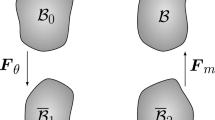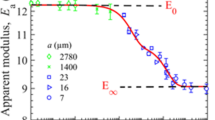Abstract
Smart hydrogels are environmentally sensitive hydrogels, which can produce a sensitive response to external stimuli, and often exhibit the characteristics of multi filed coupling. In this paper, a hydrogel rod under chemo-mechanical coupling was analytically studied based on a poroelastical model. The already known constitutive and governing equations were simplified into the one dimensional case, then two different boundary conditions were considered. The expressions of concentration, displacement, chemical potential and stress related to time were obtained in a series form. Examples illustrate the interaction mechanism of chemical and mechanical effect. It was found that there was a balance state in the diffusion of concentration and the diffusion process could lead to the expansion or the stress change of the hydrogel rod.











Similar content being viewed by others
References
Richter, A., Howitz, S., Kuckling, D., et al.: Influence of volume phase transition phenomena on the behavior of hydrogel-based valves. Sens. Actuators B Chem. 99, 451–458 (2004)
Carpi, F., Menon, C., De Rossi, D.: Bio-inspired distributed electroactive polymer actuators for possible space applications: concept design. Adv. Sci. Technol. 61, 180–185 (2008)
Huang, J.Y., Wang, L.L., Xiong, C.Y., et al.: Elastic hydrogel as a sensor for detection of mechanical stress generated by single cells grown in three-dimensional environment. Biomaterials 98, 103–12 (2016)
Hsiao, M.H., Chiou, S.H., Larsson, M., et al.: A temperature-induced and shear-reversible assembly of latanoprost-loaded amphiphilic chitosan colloids: characterization and in vivo glaucoma treatment. Acta Biomater. 10, 3188–3196 (2014)
Geesala, R., Bar, N., Dhoke, N.R., et al.: Porous polymer scaffold for on-site delivery of stem cells-Protects from oxidative stress and potentiates wound tissue repair. Biomaterials 77, 1–13 (2016)
Wang, Q.-M., Mohan, A.C., Oyen, M.L., et al.: Separating viscoelasticity and poroelasticity of gels with different length and time scales. Acta. Mech. Sin. 30, 20–27 (2014)
Kang, B., Dai, Y.-D., Shen, X.-H., et al.: Dynamical modeling and experimental evidence on the swelling/deswelling behaviors of pH sensitive hydrogels. Mater. Lett. 62, 3444–3446 (2008)
Kim, S.J., Park, S.J., Kim, I.Y., et al.: Electric stimuli responses to poly(vinyl alcohol)/chitosan interpenetrating polymer network hydrogel in NaCl solutions. J. Appl. Polym. Sci. 86, 2285–2289 (2002)
Li, Y., Sonja, K.: Elecrtomechanical responses of strong acid polymer gels in DC electric fields. Macromolecules 36, 2055–2065 (2003)
Thomas, W., Bernd, K., Jens, H., et al.: A coupled multi-field-formulation for ionic polymer gels in electric fields. Smart Struct. Mater. 4329, 264–275 (2001)
Birgersson, E., Li, H., Wu, S.: Transient analysis of temperature-sensitive neutral hydrogels. J. Mech. Phys. Solids 56, 444–466 (2008)
Li, H., Yuan, Z., Lam, K.Y., et al.: Model development and numerical simulation of electric-stimulus-responsive hydrogels subject to an externally applied electric field. Biosens. Bioelectron. 19, 1097–107 (2004)
Li, H., Luo, R., Birgersson, E., et al.: Modeling of multiphase smart hydrogels responding to pH and electric voltage coupled stimuli. J. Appl. Phys. 101, 114905 (2007)
Liu, Q., Li, H., Lam, K.Y.: Development of a multiphysics model to characterize the responsive behavior of magnetic-sensitive hydrogels with finite deformation. J. Phys. Chem. B 121, 5633–5646 (2017)
Hong, W., Zhao, X., Zhou, J., et al.: A theory of coupled diffusion and large deformation in polymeric gels. J. Mech. Phys. Solids 56, 1779–1793 (2008)
Hong, W., Zhao, X.H., Suo, Z.G.: Large deformation and electrochemistry of polyelectrolyte gels. J. Mech. Phys. Solids 58, 558–577 (2010)
Drozdov, A.D.: Swelling of pH-responsive cationic gels: Constitutive modeling and structure-property relations. Int. J. Solids Struct. 64–65, 176–190 (2015)
Hong, W., Liu, Z.S., Suo, Z.G.: Inhomogeneous swelling of a gel in equilibrium with a solvent and mechanical load. Int. J. Solids Struct. 46, 3282–3289 (2009)
Yang, Q.S., Ma, L.H., Shang, J.J.: The chemo-mechanical coupling behavior of hydrogels incorporating entanglements of polymer chains. Int. J. Solids Struct. 50, 2437–2448 (2013)
Toh, W., Ng, T.Y., Liu, Z.S., et al.: Deformation kinetics of pH-sensitive hydrogels. Polym. Int. 63, 1578–1583 (2014)
Duan, Z., An, Y., Zhang, J., et al.: The effect of large deformation and material nonlinearity on gel indentation. Acta. Mech. Sin. 28, 1058–1067 (2012)
Liu, Z.S., Swaddiwudhipong, S., Hong, W.: Pattern formation in plants via instability theory of hydrogels. Soft Matter 9, 577–587 (2013)
Zhang, T., Yuk, H., Lin, S., et al.: Tough and tunable adhesion of hydrogels: experiments and models. Acta. Mech. Sin. 33, 543–554 (2017)
Liu, Z.S., Swaddiwudhipong, S., Cui, F.S., et al.: Analytical solutions of polymeric gel structures under buckling and wrinkle. Int. J. Appl. Mech. 03, 235–257 (2011)
Yang, Q.S., Tian, H., Qin, Q.H.: Analytical solutions for a one-dimensional chemo-mechanical coupling problem. Acta Mech. Solida Sin. 27, 137–145 (2014)
Mazaheri, H., Baghani, M., Naghdabadi, R., et al.: Coupling behavior of the pH/temperature sensitive hydrogels for the inhomogeneous and homogeneous swelling. Smart Mater. Struct. 25, 085034 (2016)
Abdolahi, J., Baghani, M., Arbabi, N., et al.: Analytical and numerical analysis of swelling-induced large bending of thermally-activated hydrogel bilayers. Int. J. Solids Struct. 99, 1–11 (2016)
Chen, X., Dai, H.-H.: Swelling and instability of a gel annulus. Acta. Mech. Sin. 31, 627–636 (2015)
Salvekar, A.V., Huang, W.M., Xiao, R., et al.: Water-responsive shape recovery induced buckling in biodegradable photo-cross-linked poly(ethylene glycol) (PEG) hydrogel. Acc. Chem. Res. 50, 141–150 (2017)
Yang, Q.S., Ma, L.H., Liu, B.S.: A continuum theory and numerical procedure for chemo-mechanical coupling behavior. Chin. J. Theor. Appl. Mech. 42, 422–431 (2010). (in Chinese)
Acknowledgements
The financial supports from the National Natural Science Foundation of China (Grants 11472020, 11502007, and 11632005) and Hong Kong Scholars Program (Grant XJ2016021) are gratefully acknowledged.
Author information
Authors and Affiliations
Corresponding author
Rights and permissions
About this article
Cite this article
Wang, XQ., Yang, QS. A general solution for one dimensional chemo-mechanical coupled hydrogel rod. Acta Mech. Sin. 34, 392–399 (2018). https://doi.org/10.1007/s10409-017-0728-x
Received:
Revised:
Accepted:
Published:
Issue Date:
DOI: https://doi.org/10.1007/s10409-017-0728-x




